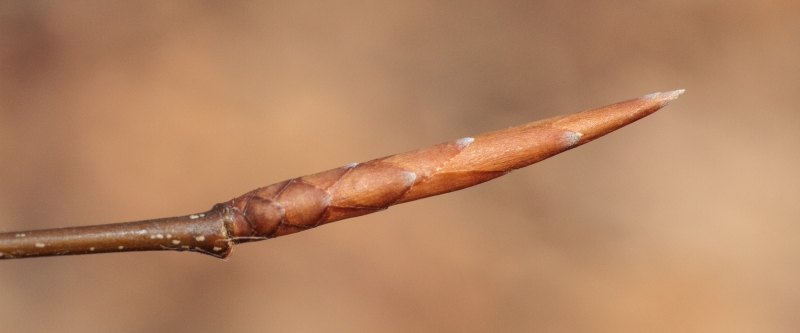
American Beech Bud: Kendrick Fowler
Beech Gone Wild: Raging Hormones
The American beech (Fagus grandifolia) has been slowly dying out for the last 140 years. As a result, beech saplings have overrun many woodlots, making them less diverse, less vigorous, and less valuable.
That’s right – beech decline has led to a beech proliferation so extreme that in some places they are a barrier to forest regeneration. I’d call this an oxymoron, but don’t want to insult the bovine community. Strategies do exist to address this problem, though.
Long-lived and stately, beech grow throughout eastern North America from Wisconsin and Missouri east to the Atlantic, and from northern Florida all the way to northern Ontario and Quebec. In northern New York, the beech family (Fagaceae) contains over a dozen oak species, yet has but one native beech, making me wonder how beech got to lead the clan. Historically, beech was a keystone species in many long-term stable forest communities. From mice to grouse to black bears, a host of wildlife once relied – and still do to an extent – on beech nuts.
In the late 1800s, a European scale insect arrived in Nova Scotia. Simply called the beech scale (Cryptococcus fagisuga), this soft-bodied pest ranges from 0.5 to 1 mm long, or in non-metric terms, wicked-small to crazy-small. The frail, flightless pest can’t even crawl, except for briefly upon hatching; it passively disperses on wind or birds’ feet. Once on a beech trunk, it inserts a thin stylet into the phloem and takes a wee sip of tree juice. So far, it doesn’t sound too menacing.
We’re living through a nasty demonstration of what microbes a bazillion times (well, at least a quadrillion, but I forget what comes after) smaller than us can do. Similarly, the minute beech scale can slay trees millions of times their size through a scheme of rather permissive family planning.
Beech trees could probably handle throngs of insects each robbing a taste of sap. But every time a scale’s micro-straw jabs through the bark, a native fungus in the genus Nectria comes with it and engages in rotten behaviour. This unhurried decimation is termed beech bark disease.
Beech-scale insects exude white filamentous wax, and large infestations look like fuzz or white mold. Rough, puckered areas of bark indicate Nectria has killed the phloem beneath and is busy turning wood to sponge. Dead patches eventually merge, cutting off water to the crown.
But all that’s beside the point. This is really about why hormone imbalance is a threat to forests.
A beech tree’s post-mortem baby boom is related to how it procreates. Like poplars, beech spread by root sprouts, clones of the mother tree, and seed production. Overstory beech crank out growth-inhibitor hormones to stifle the mass-emergence of root sprouts. They don’t want competition while they’re in charge.
When a mature beech dies, hormone constraints go, too. With no mother tree keeping things in check, it’s “bring in the clones.” Given that a tree’s root zone is three times its branch length, every sizeable beech that expires creates a broad, dense monoculture of saplings. Curiously, beech scale doesn’t often attack trees under 8” in diameter, which is why root-sprout saplings are not controlled by beech bark disease.
Never mind that they’re the bane of maple producers trying to run tubing, and mess things up for hunters by retaining leaves all winter; beech thickets inhibit forest regeneration. Anything that interferes with the natural regrowth of a diverse woodland will lead to a less productive and less resilient future forest. Competition for water and nutrients is minor compared to the battle for sunlight. A mini-forest of sprouts will one day succumb to beech scale, but not before they shade out everything else.
In terms of mechanical control, it’s a lot more effectual to cut in early summer just after leaf-out is complete. This puts the maximum strain on the organism. By late summer, a season’s worth of photosynthate has been tucked away for next year.
Even in small woodlots, severing countless beech stems at the base is daunting. Chainsaws are a poor option, as working bent-over strains the back and quickly fatigues operators, increasing the chance of mishap (plus in my experience, saw chains are magnets for hidden rocks). A pro-model string trimmer with a circular blade is easier on the back, but there remain issues of fatigue and potential injury.
Canadian research concluded that “high stumping” at about 3 feet was as effective as basal cutting. With a two-handled lopper, there’s no bending, and less risk of injury. Cutting stems with a brush head on a small tracked vehicle is likely the best method for large tracts.
Don’t laugh if you haven’t heard of flame-weeders, but they’re used to burn the basal cambium of small trees. With such fire potential, early winter with a veneer of snow may be the only safe window to work. Bark should be heated until well-done, as I’ve seen “undercooked” trees live through flame treatment. Mechanical controls are typically repeated for several years.
Admittedly, chemical control is effective, but organic certification, environmental and/or health concerns, or municipal by-laws might nix it. Concentrated (25% to 50%) glyphosate is dabbed or painted on beech stumps within 72 hours of being cut. Timing is crucial: cut-stump treatment is far more successful in early fall when woody plants move sugars and nutrients into the roots. When done properly, around 90% of beech saplings are killed by one application.
I suggest hiring a professional forester to help with beech-thicket control, especially if chemical use is on the table (figuratively, of course). Peter Smallidge, Cornell Extension Forester for NY State, has great articles and YouTube demonstrations. Find links at https://cornellforestconnect.ning.com/forum/topics/beech-management-1
Paul Hetzler is an ISA Certified Arborist, and a former Cornell Extension Educator.

